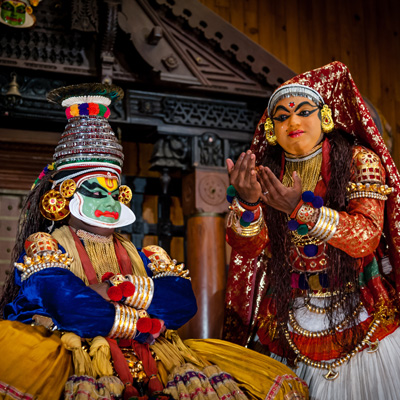
Kathakali Dance
Kerala, "God's Own Country" is a treasure house of rich culture and tradition. The unique and diverse range of traditional art forms makes Kerala distinctive from other states of South India. The traditional Kerala art forms not only attracts domestic tourists but also international tourists from all across the globe.
Kathakali Dance - Kerala
Kerala is endowed with numerous art forms which are mainly divided into three categories; namely - Kerala Hindu Arts, Kerala Christian Arts, and Kerala Muslim Arts. Kathakali, Mohiniyattam, Chakyar Koothu, Nangiar Koothu, Thullal, Ottamthullal, Thiruvathira, Krishnanattam, Koodiyattam, etc come under Kerala Hindu Arts. Whereas Margam Kali, Chavittu Nadakam, Parichamuttukali, Slama Carol, etc are Kerala Christian Arts and Oppana, Mappila Paattu, Kolkali, Duff Muttu, etc are Kerala Muslim Arts. These art forms are portrayed mainly during celebrations and festival season in Kerala, but for the convenience of tourists, shows are also performed.
Kathakali is the most well-known dance form among the other traditional art forms of Kerala which combines aspects of ballet, masque, opera, and pantomime. Soaked in the essence of the Indian spirit, Kathakali is the leading classical dance of India. The origin of this art form of Kerala dates back to the 17th century.
And it is believed to have originated from 'Ramanattam' and 'Krishnanattam' which are two main art forms of Kerala. Unlike other classical Indian dances which were primarily developed in Hindu temples and monastic schools, Kathakali was developed in courts and theatres of Hindu regions and it was traditionally performed by male artists.
Kathakali is a typical dance drama which resembles other Indian classical dance arts. The Kathakali performers enact the story through impressive hand expressions, excellent footwork, body movements and facial expression especially with eyes, which are complemented with music and vocal performance.
Kathakali music comprises of Carnatic ragas and orchestra with traditional instruments of Kerala like the Chenda, Maddalam, Idakka, Shankhu, Chengila which is a bell gong, and Ilathalam referred to as a pair of cymbals. The ornamental, elaborate and colourful makeup and costumes are the major highlight of Kathakali art form which helps the audience to understand the gestures and expressions more clearly.
The costumes are very heavy and large in size. Different characters have different costumes which are known by different names. The costume of the hero is known as Sathwika. The costume of the female is known as Minukku and Thatti and Kathi are the costumes for villains. Multi-colored jackets, scarves and plaited skirts are also worn by the characters. These elaborate costumes and mask of Kathakali have become the most recognized icon for Kerala.
The theme of this art form is taken from spiritual ideas, religious legends and folk mythologies of Hindu epics and the Puranas and the vocal performance is performed in Sanskritised Malayalam. In modern composition, the theme is adapted from western stories, Christianity as well as plays of Shakespeare and the Indian Kathakali troupes have included female artists also.
The Kathakali performance starts with Kelikottu in which the performer calls the audience to attention. Next comes the Todayam in which the characters invoke the blessings of the gods. Todayam is followed by Purappadu which is a pure Nritya piece. Melappada comes after this where the musicians and drummers entertain the audience. All the remaining characters make their first appearance in Thiranokku.
After that, the dance drama with a particular theme chosen from the Indian mythology or Puranas begins. Kerala Kalamandalam, Ernakulam Kathakali Club, Folklore Museum, Dr Devan’s Kathakali, Kairali Kathakali, Kerala Kathakali Centre, Rhythms Theatre, Margi School Trivandrum, Kadathanadan Kalari Centre & Navarasa Kathakali are some of the best places in Kerala to watch live Kathakali performance.